The maker of the world's fastest car blames an editing 'mixup' for a misleading video that internet detectives raced to debunk
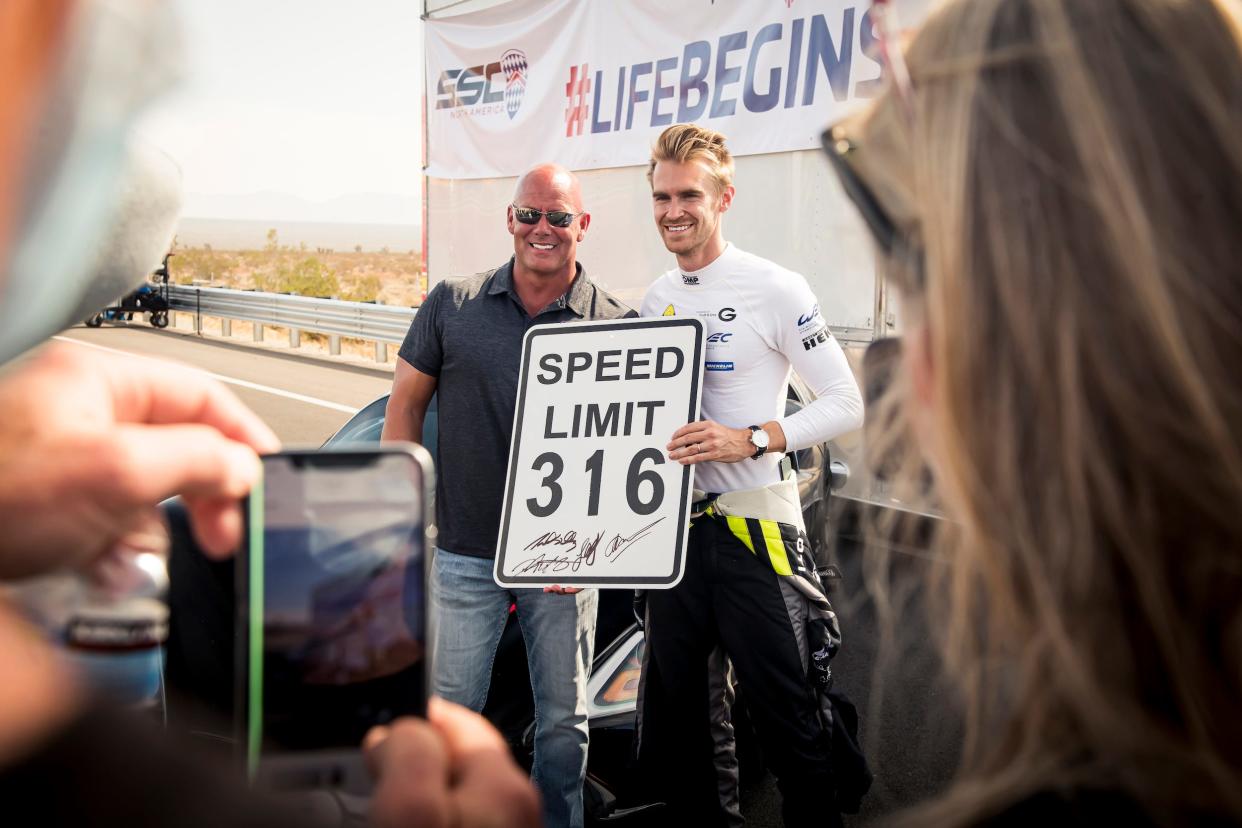
On October 10, SSC North America broke the fastest production car record with its 316-mph Tuatara.
The legitimacy of the record was called into question, however, after skeptics, including prominent YouTuber Shmee, noticed some inconsistencies in SSC's video of the feat.
SSC ended up saying that it is "regretful that the videos shared were not an accurate representation of what happened."
Just a week after announcing that its Tuatara had become the world's fastest production car, boutique automaker SSC North America is defending its prize. Not from another car or automaker, mind. From the internet.
On October 19, news broke that the new SSC Tuatara had averaged a speed of 316 mph on two runs and achieving a maximum speed of 331 mph after testing on October 10. That smashed the record that the Bugatti Chiron Super Sport had previously put in place, at 304.77 mph.
This is impressive for a number of reasons, chief among them being that SSC North America is a little-known, very small supercar manufacturer located in Washington state. Founded in 1998 by Jerod Shelby (no relation to Carroll Shelby), SSC had set the record for the world's fastest production car in 2007 with the Ultimate Aero Twin Turbo at 255.83 mph.
That mark stood until 2010, when the title was claimed by the Bugatti Veyron Super Sport at 267 mph.
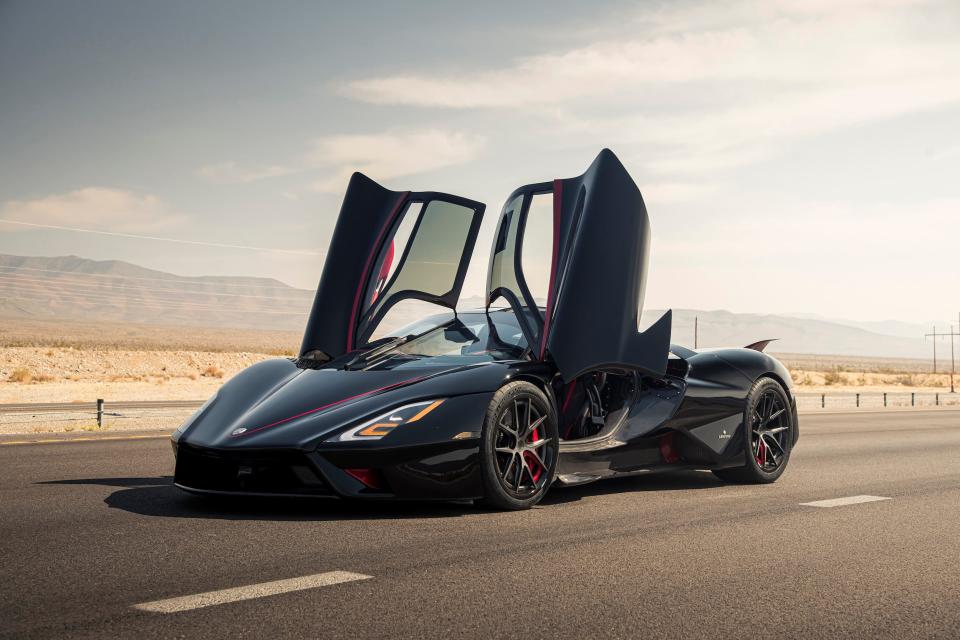
Compared to Bugatti, which has all the money and resources that multi-billion-dollar global automaker Volkswagen can give it, SSC is tiny. The fact that this small US company said that it managed to stick it to the far more famous brand, in terrific underdog style, made you sit up and pay attention.
And then the internet stepped in.
Soon after the initial flurry of news, questions of the record's legitimacy started rolling in.
Across Facebook groups, Reddit threads, and YouTube, sleuths debated SSC's record, running numbers of their own and picking apart the available video footage. Among the most prominent of skeptics was automotive YouTuber Shmee, who posted a video titled, "Did the SSC Tuatara REALLY Set a 331mph World Record?" to his 2.15 million channel subscribers.
In the video, Shmee grouped his evidence into three categories.
First, he examined the stretch of State Route 160 in Nevada where the Tuatara set its record. Using three center medians as visual bookmarks, he approximated the distance between them using Google Maps and determined how much time the Tuatara spent getting from one to the next using SSC's video of the high-speed run.
Shmee determined that the distance between the first and second median was about 1.13 miles. It took the Tuatara 22.64 seconds to travel between them, and because distance equals speed multiplied by time, that would put the car's average speed at 179.7 mph. However, judging from the digital speed overlay in SSC's video, the Tuatara appeared to cross the first median at 192 mph and the second at 307 mph.
The distance between the second and third median was 1.42 miles and the Tuatara took about 24.4 seconds to travel between them, with Shmee calculating the average speed between them to be 209.5 mph. Here, the digital overlay displayed a 307-mph entry speed and a 242-mph exit speed.
In both instances, the car's video overlay said it was traveling faster than what its average speed should have been, based on Shmee's math. Nowhere in the video did the Tuatara appear to slow down dramatically enough to result in the lower average speed.
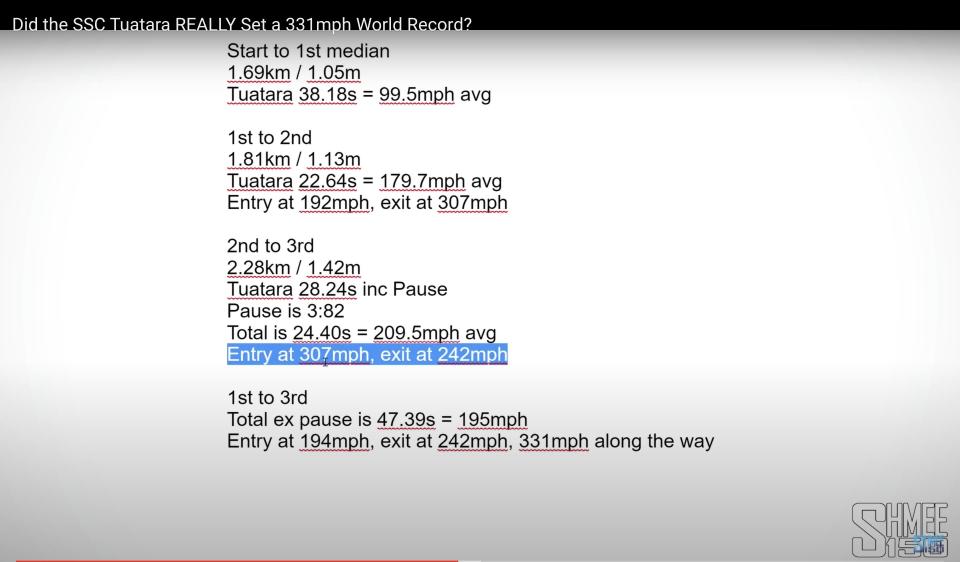
And since Swedish automaker Koenigsegg used that same stretch of road in 2017 to set the production car record in its Agera RS, Shmee lined up footage of both cars doing their runs and played the videos simultaneously and in real-time. He found that the Agera RS reached the third median before the Tuatara, despite the Tuatara's digital speed overlay displaying it running at a higher speed.
Shmee also drew attention to the Tuatara's actual speedometer — not the digital speed overlay or the laptop in the car also displaying the speed — as appearing blurred out. He said the last number you can see on the speedometer is 301 mph.
Finally, the pro racing driver who set the Tuatara's record time, Oliver Webb, said that the 331-mph speed was achieved while the car was in sixth gear. Using gear ratios from a CIMA transmission, which is found in the Tuatara, and its tire size, Shmee calculated that the car, even sitting at its 8,800-RPM redline in sixth gear, could only do about 293 mph in sixth.
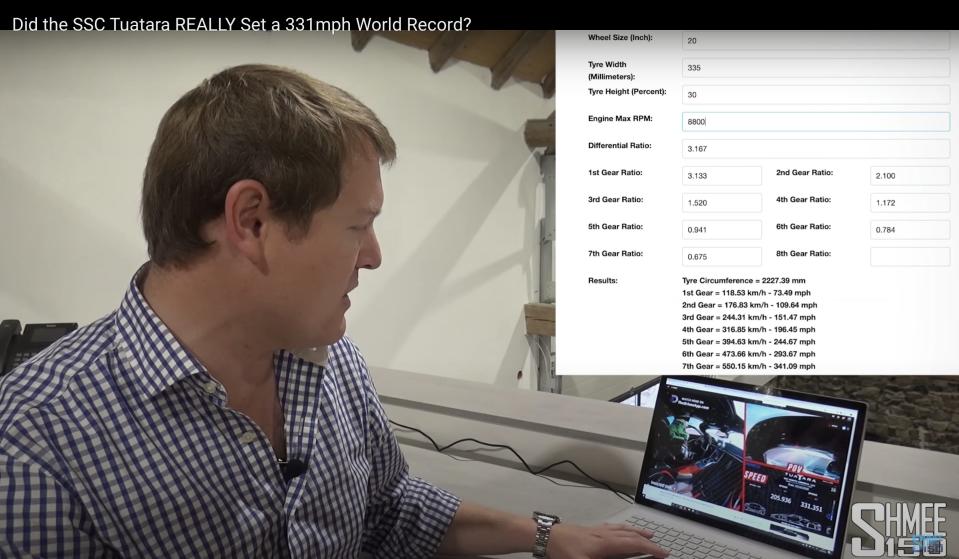
"There are so many open questions," Shmee told Business Insider. "The video presented has numerous flaws."
He said he believed that SSC was aware that he was looking into its record. He stands by his video and said that it doesn't detract from the incredible fact that a small team such as SSC can make a car that can steal Bugatti's — Bugatti's! — lunch. If that's what really happened, of course.
Put another way, he wanted to see the receipts. "If the Tuatara did what [SSC] said it did, it would take seconds to prove it," he said.

SSC said that it used technology from Dewetron, an Austrian GPS data-measurement company, to chart the Tuatara's speed. In an October 26 press release, it said that Dewetron validated the Tuatara's claimed top-speed run and that it had worked with Dewetron before. "Four out of five of the last world top-speed records were measured and validated on the same Dewetron system," the company said.
On Wednesday, however, Dewetron said not so fast.
"Despite the information published on the website of SSC North America well as on several related and non-related YouTube channels, Dewetron did not validate any data from world record attempts or preceding tests. Not one of Dewetron's employees was present during the test drive or involved in the associated preparations," the statement read.
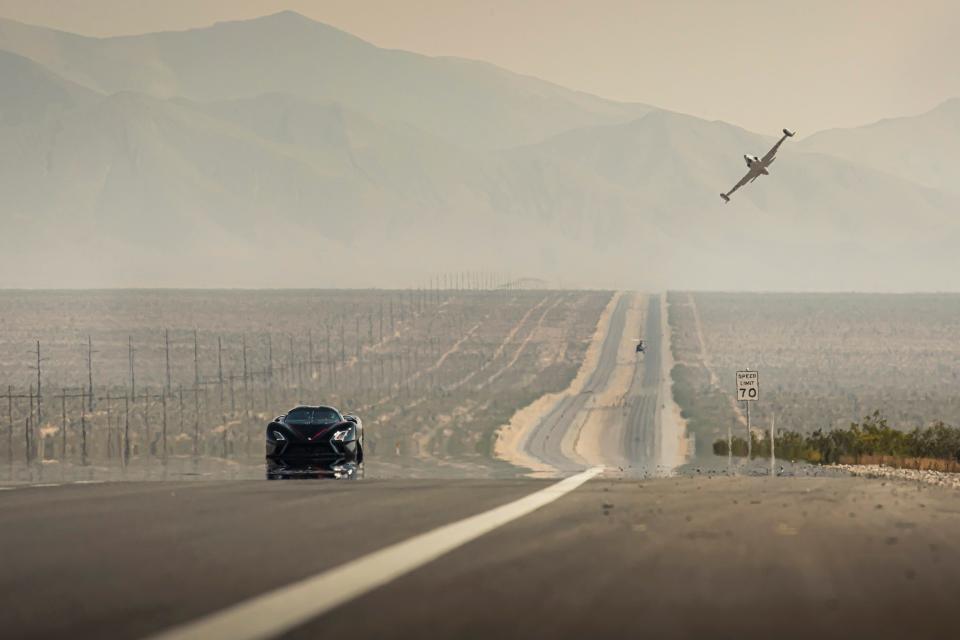
Dewetron acknowledged that SSC used its test and measurement system, but said that customer training only goes over "general use of the system, the software, as well as the initial configuration."
"The training does not include the creation of any setup related to any given test," it said.
Separately, Dewetron also said that, contrary to SSC's claims, it was not involved in "'four out of five' of the last top speed records," according to CarThrottle.
The speed claim became so debated and fought over that even the man driving the car wasn't sure of what had happened. In a video on his personal Instagram page, Webb said that he knows nothing more than "what he's finding out online." He, like everyone else, is waiting for factual evidence.
Jerod Shelby, SSC's founder and CEO, released a statement shortly after Dewetron distanced itself from the record. He stands by the speed that the Tuatara achieved, but admitted there was "a mixup on the [video] editing side" and that the SSC team "hadn't double-checked the accuracy of the video before it was released."
"We also hadn't realized that not one, but two different cockpit videos existed, and were shared with the world," he said. "At first glance, it appears that the videos released have differences in where the editors had overlaid the data logger (which displays speed), in relation to the car's location on the run. That variance in 'sync points' accounts for differing records of the run."
The company says that it's working with its video team to "release the actual footage in its simplest form," which it will share as soon as it has it.
Finally, SSC said that it received a letter from Dewetron on October 22 that confirmed the "accuracy of the equipment and speed sensor" it had supplied SSC.
You can read the statement below in full:
On October 10, 2020, SSC North America realized a dream that was a decade in the making, when our Tuatara hypercar achieved an average top speed of 316.11 MPH.
In the days since, there has been a swirl of interest and speculation about how and whether the Tuatara had achieved that speed.
The good news: we did it, and the numbers are indeed on our side.
The bad news: only after the fact did we realize that the depiction of the speed run, in video form, had been substantially incorrect.
The following is a long explanation of what and how this happened, to the extent we now know. I hope it will serve to build trust in the SSC team, and in the exceptional feat the Tuatara has earned.
The video
Three years ago, SSC began working with Driven Studios, a video team to document what seemed like every waking moment of the Tuatara hypercar and those who've created it.
They've since interviewed virtually every team member and consultant, captured the car in build and throughout extensive testing, and have played a key role in not only capturing, but in producing the record run on October 10 in Pahrump, Nevada. They have become a trusted partner of the SSC family.
On the big day, October 10, there were video cameras everywhere — in the cockpit, on the ground, and even secured on a helicopter a low-flying T33 to capture the car at speed.
The morning of the run, the record was achieved, we were over the moon. We kept the news under embargo until October 19, with hopes of releasing a video to accompany the press release.
On October 19, the day the news broke, we thought there were two videos that had been released -- one from the cockpit, with data of the speed run overlaid, and another video of b-roll running footage. The cockpit video was shared with Top Gear, as well as on the SSC and Driven+ YouTube pages.
Somehow, there was a mixup on the editing side, and I regret to admit that the SSC team hadn't double checked the accuracy of the video before it was released. We also hadn't realized that not one, but two different cockpit videos existed, and were shared with the world.
Hypercar fans have quickly cried foul, and we hadn't immediately responded, because we had not realized the inconsistencies -- that there were two videos, each with inaccurate information -- that had been shared. This was not our intention. Like me, the head of the production team had not initially realized these issues, and has brought on technical partners to identify the cause of the inconsistency.
At first glance, it appears that the videos released have differences in where the editors had overlaid the data logger (which displays speed), in relation to the car's location on the run. That variance in 'sync points' accounts for differing records of the run.
While we had never intended for the video captured to play the role of legitimizing the run, we are regretful that the videos shared were not an accurate representation of what happened on October 10.
Driven Studios does have extensive footage of everything that transpired and is working with SSC to release the actual footage in its simplest form. We'll share that as soon as it's available.
How the Speed Was Measured
The SSC team received a piece of Dewetron equipment for its use in the speed run. The SSC team was trained remotely (due to COVID) on the use of that equipment.
The Dewetron equipment includes sensors placed in the vehicle, that tracked an average of 15 satellites over the course of the Tuatara top speed run.
Two independent witnesses, not affiliated with SSC nor Dewetron, were on site to view the speeds measured by the Dewetron equipment. SSC intends to submit proof of what those witnesses had seen on the Dewetron equipment to Guinness for verification.
On October 22, Dewetron sent a letter to SSC confirming the accuracy of the equipment and speed sensor they had provided to SSC, and that letter will also be submitted to Guinness as part of application for the world top speed record.
As an additional step, SSC is in the process of submitting the Dewetron equipment and speed sensor for further analysis and verification of that equipment's accuracy.
In response to Shmee's gear ratio calculations and Business Insider's follow-up email, SSC provided the Tuatara's technical specs:
Ratios/speed, using the 2.92 final-drive ratio
Gear ratios/top speed (gears one through six have 8,800 RPM rev-limit)
First gear: 3.133 / 80.56 mph
Second gear: 2.100 / 120.18 mph
Third gear: 1.520 / 166.04 mph
Fourth gear: 1.172 / 215.34 mph
Fifth gear: .941 / 268.21 mph
Sixth gear: .757 / 333.4 mph at 8,800 RPM
Seventh gear: .625 / 353.33 MPH (Estimated maximum at 7,700 RPM in seventh gear. Designed as mainly an overdrive highway cruising gear.)
Tires:
Michelin Pilot Sport Cup 2
88.5-inch circumference
28.185-inch diameter
The numbers are slightly different than the ones Shmee had, particularly the final-drive ratio (or differential ratio, as he called it) and the sixth-gear ratio. Per SSC's math, the Tuatara does indeed appear geared to be able to hit 331 mph while in sixth gear.
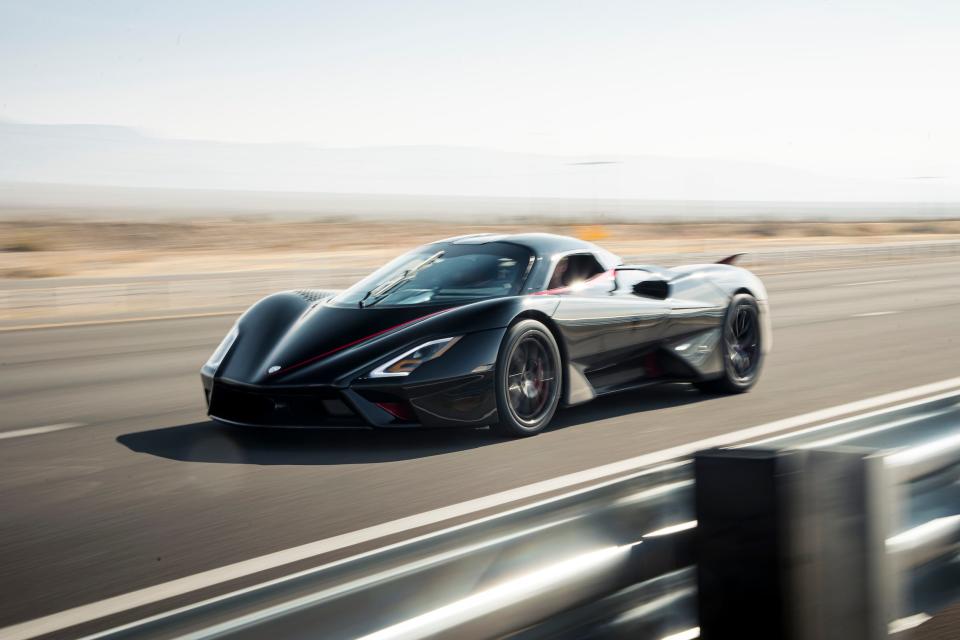
So now, we're left now waiting to see SSC's new footage of the run.
You can write this off as just a dumb spat between some internet sleuths and a boutique car company you've never heard of. But production car speed records don't happen every day, especially in spectacular David-and-Goliath fashion such as this. To the people who care about this stuff — enthusiasts, automakers, buyers who insist on having whatever's fastest — it matters.
This also means that any company that plans to use superlatives such as a world record to help sell its cars must know that the internet will invariably come for it. In 2017, when Lamborghini said it set a new Nürburgring lap time in the Huracán Performante, it had to fight off heavy skepticism.
There will always be internet detectives, and if you release a video of your record run, you can almost guarantee that it will get picked apart. SSC stands by its numbers and its record, but also admitted to inconsistencies in its published video. It is working on getting another version out.
Once that happens, it will hopefully put the issue to rest. At least until the next fastest car comes along.
Read the original article on Business Insider

